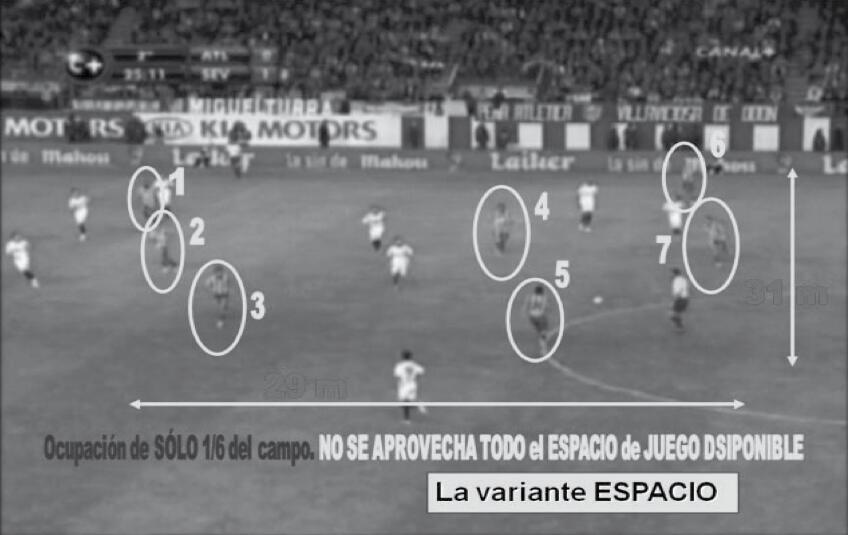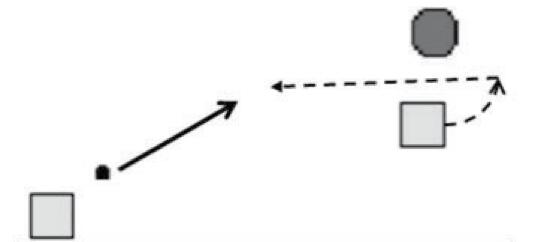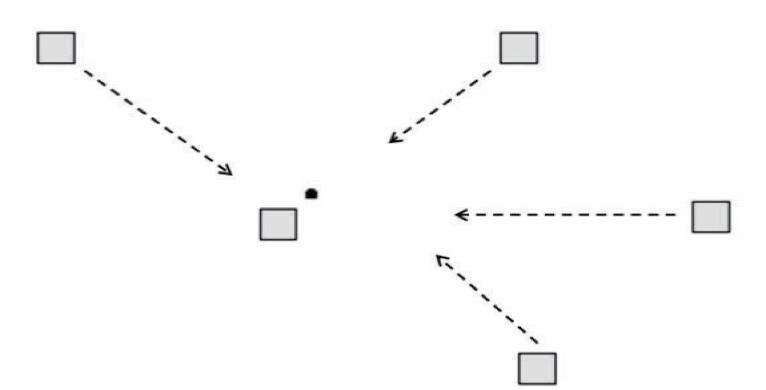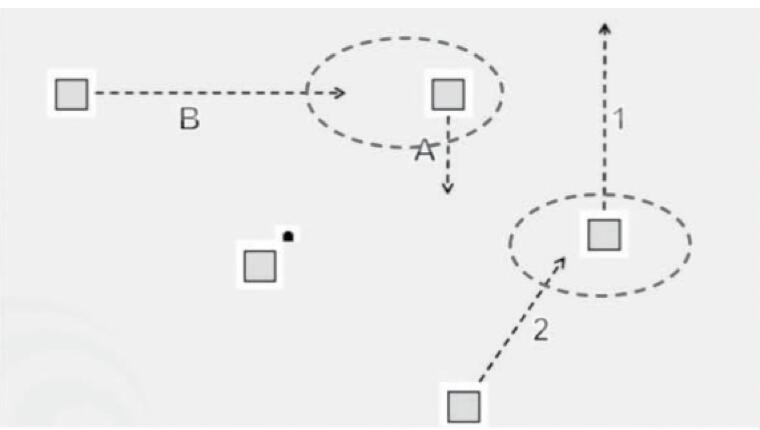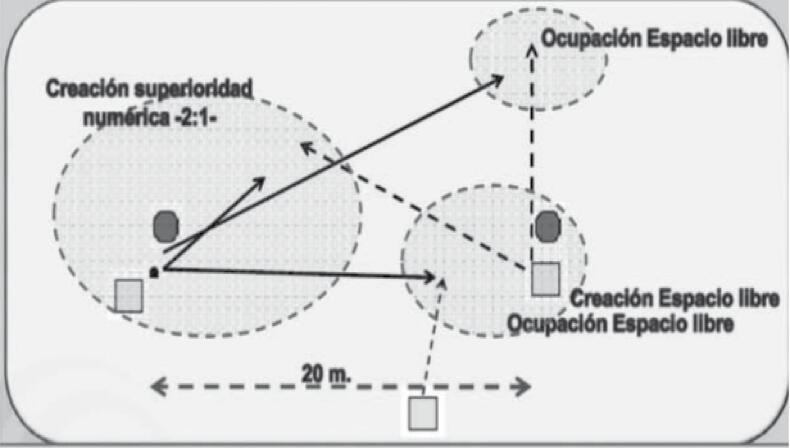THE NEED FOR COLLECTIVE PLAY TO DEVELOP ASSOCIATIVE AND/OR POSITIONAL PLAY EFFECTIVELY
Let's look at some empirical results obtained with our work in the field, endorsed with theoretical considerations of proven authors:
In each Game Situation players who do not have the ball must make the moves that facilitate the holder's game, having to:
- Occupy the demarcation of the holder (creating SN /2:1).
- Appear in existing or created free space.
From a correct structural location, players without a ball that are in the orientation of the game will make, when necessary, a long displacement leaving their zone/demarcation, to:
- Occupy a free space:
- Existing in the game system, or the
- Create a 2: 1 numerical superiority situation:
- Previously generated by a partner.
- Occupying the owner's area.
- Generating in turn with this action a new free space that can be occupied by another companion...
In attack we observed that:
- A team has a working space of 2,700 m2. (The offside rule exists).
- Each player has a zone/demarcation of 400 m2. (20x20m).
These spaces can be used by moving the ball with direct pitches of 40-60m with some precision. This space must be "managed" so that:
- There is a distance between 15-20 m between players.
- Less than 15 m., space is reduced by facilitating defensive action.
- More than 20 m., the travel time of the ball allows rectification/anticipation of the opposite.
No opposition with only 10 men can effectively remove all play spaces, whatever type of marking (individual or collective) you use.
The only chance to eliminate spaces in the face of short play style is by accumulating players in the play area. This action, however, enables large spaces in the areas opposite the ball. In this case, the use of long distance passes (+- 40 m) will provide us with the intended objective.
From the manifestation of a correct structure we can overcome the opposite in each zone/demarcation:
- In a 1:1 situation with output space (Using a technical action).
- In a 2:1 situation (Through tactical action).
- In a situation 2:2 or more (Through a collective action that will allow the achievement and manifestation of tactical technical actions in 1:1, 2:1 and 1:2, with the training and application of the fundamentals/movements of the system).
In attack: Each player can be in 3 different situations:
- Being in possession of the ball.
- Be (no ball) in the game orientation (you can receive the ball directly).
- Be (without a ball) outside the game's orientation.
In defense: We also distinguish the following situations:
- Mark the opposite that you own or receive the ball (tactical situation).
- Cover the partner that marks the opposing holder, 2:1 numerical superiority situation in defense (tactical action).
- Mark the opposite without a ball found in the game's orientation (collective action).
- Mark the opposite without ball that is NOT in the orientation of the game (collective action).
These three situations manifest themselves in the realization of:
- A DEFENSIVE VIGILANCIA.
- A "DEFENSIVE FIXING".
- An INDIVIDUAL MARK.
- Recovery INPUT.
- DEFENSIVE COVERAGE.
Concept of “Opportunity":
This is the precise moment when the Application of the Consignment allows you to resolve the Game Situation. This is the manifestation of talent that the player must possess without a ball.
The foundation will advise us/help us learn to detect this timely moment.
Of all possible displacements in each Game Situation, each player must make the one that is optimal, at the right time, in a coordinated manner with their teammates (marking the times in relation to the possibilities of the holder).
"Creating spaces at the beginning of the collective game”:
- In a positional/associative attack we should not start the progression phase without first making at least 2/3 orientation changes (direct or indirect) in the start phase.
- In this way we will provoke lanes/skilful spaces to achieve the intended goal in the progression sub-phase (control ball in the completion phase).
Once the Game System to be used has been established by the coach, the movements/foundations of that system (which will be based on the Universal Fundamentals) must be determined.
From this basic preparation of the training, in each match you must enter the necessary variants caused by:
- The characteristics and needs of the equipment.
- The Opposition.
In this way players will be able to perform the movements and the set game:
- With a maximum execution speed.
- Avoiding mistakes typical of incorrect decision-making (safety in ball manipulation).
- A great anticipation is expressed in situations 1:1.
In order for all this to be possible we must establish a new area in coach training and player training (in addition to technique, tactics, physics and psychological), which allows them to:
- Know your collective role.
- The domain of the factors: Space/Time/Opportunity (FUNDAMENTS).
The Basics allow, in each SJ, that players who:
- THEY are in the orientation of the game occupy/appear in the spaces determined to make possible the game of the holder (in the sub-phases of start and progression / completion) ensuring that the ball is not lost (appearance of numerical superiority -2:1- ).
- THEY ARE NOT in the orientation of the game to provide defensive security in the face of a possible loss.
Therefore each player, in each SJ, must know what to do and what their partner will do.
How does a training based on reduced effective situations contribute to errors detected in decision-making?:
- They cause misconceptions:
- Decision-making contrary to the correct ones in a situation of 11:11 –e/t/o-
- It is played as he has trained, in the match he performs what he has trained.
- Non-specificity of training.
- The distances and spaces of football are not respected.
- They have a higher level of difficulty than the SJs that should be presented in the real game
- Which causes constant loss of the ball.
- They cause a decrease in individual resources in the players by manifesting:
- A clear numerical inferiority.
- An excess of players in a demarcation.
If we analyze a team in a 4:4 activity in a space of 30x30 m for 10 minutes, how many times does this team lose control of the ball?
We are training and giving as valid, and therefore educating the player "to lose the ball". Then, in the match, we cannot be surprised that the continuous collective losses of the ball are assumed as normal, and there is no analysis of the causes that cause them ("football is football", "in football everything is invented",...).
In football, the various factors that act, and the multiple interactions that occur during game development, cause a player to be able to decide the most appropriate action at every moment of the match.
In this situation:
The holder's partner and defender will reach the ball (control or interception) based on their reaction speed and strength. If the holder's partner knows what to do, and the holder knows what he will do, he will have an advantage over the defender through a simple trick ("darken" the defender).
When each player unilaterally decides in each SJ what they will do to help the holder, situations can manifest that not only do not help the holder, but cause situations of lack of space with removal of pass lines.
If CONSIGNMENTS exist for each player in each SJ, and are applied at the "timely time" (coordinatedly), situations of numerical superiority with the holder (2:1) and/or use of free spaces (from the System or generated by a partner) will be constantly created:
In a 2:2 situation (minimum manifestation of a collective situation), if an optimal exit movement of the area is made to create numerical superiority or take advantage of free spaces, the DEFENSOR must make a decision between two options:
- It stays in the... Which allows us to receive the ball.
- It follows us... A free space will be created that can be taken advantage of by another partner (from the previous line where SN existed).
In any case there will always be a solution for any SJ that will allow not to lose the ball, overcome the opponent and / or progress
"The Fundamentals of Football" allow THE PLAYER (without waiting for the mechanisms of perception and decision-making to be implemented, and recognizing the SJ in which he is located) CAN APPLY THE ESTABLISHED SOLUTION (CONSIGNA), drastically reducing:
- The process of analysis of the decision-making mechanism.
- The possibility of a loss of the ball.
It is ultimately about making the situations in which the player is "less open".
Through the foundation the player knows the CONSIGNA to apply (knows before receiving the ball the action to be executed) reason why he will have "more time" to execute it.
This increased availability of time allows the player to:
- It may "fix" one of the LEI-specific e/t/o factors, which makes it possible to manifest an action other than THE CONSIGNA.
- In these circumstances we will allow the player to improvise alternative actions, as they greatly help to surprise the opposite.
- Focus your attention on the technical action to be performed, an aspect that increases:
- Your execution level (accuracy).
- The speed at which it runs.
- Use this time to manifest actions of talent / improvisation.
We have statistically analyzed that decision-making errors are the cause of more than 80% of the ball's losses.
However, the training content is composed of 90% of execution aspects. We must therefore design training activities that help us improve and/or eliminate the large number of decision-making errors (FUNDAMENTS).
FACTORS THAT PREVENT THE MAKING OF CORRECT DECISIONS (causing most of the mistakes that are made in the Associative Game).
We note that football continues to undergo a process in which the game's own interactions are increasingly affected by the growing presence of several momentous factors:
- The level of pressure to which the adversary subjects us.
- Lack of spaces in certain game situations.
- The short time the player has to make the best decision (among all possible options) in a coordinated manner with the rest of the teammates.
- The stress of the competition, often increased by the importance of an outcome, by responsibility, etc.
- Highly complex game situations due to the direct participation of multiple variables (ball, teammates, opponents, etc.) that modify their incidence extremely quickly (sudden and continuous alteration of the space/time/opportunity factors of the game situation).
- This causes a correct decision to stop in a short space of time (2-3 seconds).
- Incorrect play habits acquired during training through reduced effective situations in which in the space of a demarcation (in which we should only have one player) evolve between 6 and 8 players (between attackers and defenders).
- Existence of multiple possible answers in each game situation.
All this prevents our player, however talented he has, from being able to decide correctly, in a regular and coordinated manner with the rest of his teammates, which are the most appropriate options.*
This is the reason that in a high-level match, of the approximately 100 competition units that manifest themselves during the 90 minutes, only the expected objective (finish) is achieved by 10% at most.
Currently, efforts are made to reduce decision-making errors in the following ways.
- Through training based on reduced effective situations.
- We will see that these not only do not solve the problem, but significantly aggravate it
- Through training based on automation.
- They are also not effective since, in addition to nullify talent:
- They hardly "come out" during the competition.
- They're predictable by the opponent.
- Entrust yourself to the individual talent of the players.
- Even if great players are available, the extreme complexity of 11:11 means that a high number of ball losses caused by wrong decisions (70-80) continue to manifest.
Given this impossibility, we must find new learning proposals that allow:
- Respect the aspects that characterize the specificity of football. For this reason we must rely on training in the use of real game situations.
- Avoid the extreme complexity that appears when that specificity is respected.
To do this, the only solution is to reduce the number of elements to be analyzed, which will allow us to reduce the name of possible decisions to be made with their consequent actions to be taken.
To achieve this, we start from the idea that, for each game situation, there are slogans that allow us to solve it. Therefore, we must have a closed list of game situations.
To have this list we had to:
- Consider the many possible combinations of factors that make up a game situation:
- Space.
- Demarcation.
- Time.
- Concept of opportunity.
- Presence of companions and adversaries.
- Location and origin of the ball.
- Offensive and defensive proposals submitted by the opponent.
- Determine the specific aspects that are manifested in each game situation (recognize the game situation).
- Specify the actions (slogans) that allow us to solve each game situation.
- Check that, once these instructions are resolved, the development of a high level of play is ensured in any competition situation.

